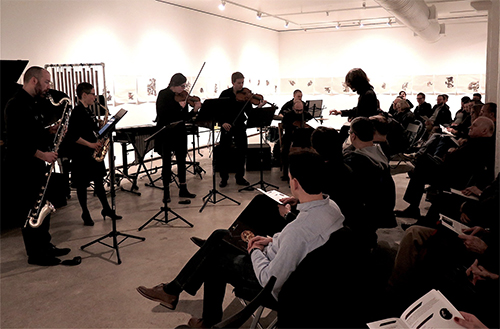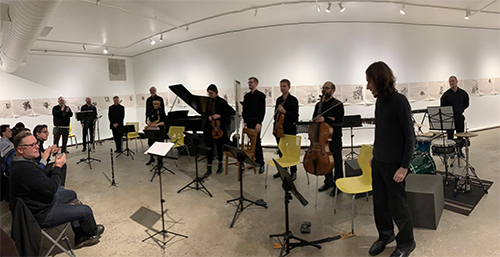by Nicholas Stevens

Directness of expression reigned throughout the evening, starting with the cozy oval of seats: performers on one side, audience opposite. Assistant director James Praznik jolted listeners to attention with Screaming Songs, his own composition. Designed to “wring vocal expressions” from all-instrumental forces, the piece succeeded: saxophonist Noa Even and bass clarinetist Gunnar Owen Hirthe achieved humanlike sounds. However, even non-wind players, such as cellist Nicholas Diodore and drummer Stephen Klunk, stretched known techniques in pursuit of the quasi-vocal. Some music calls attention to its own artifice with its clear sections and melodic play. Not this piece, which felt organic and alive, voicing its own growing pains.
Ty Emerson’s Darkling, I Listen, inspired by Keats’s Ode to a Nightingale, resembled a single painted brushstroke on an otherwise blank canvas. Variable in thickness, color, and height, drawn against silence and always threatening to run out, the line of sound appeared most fragile when Nicholas Underhill’s piano and David Luidens’s glockenspiel splattered above. Hong-Da Chin’s …the arc of a tear… zoomed in on the titular gesture of sorrow and replayed it over and over, from a new angle each time. The opposite of Praznik’s piece, it makes both local and long-term processes plainly audible. In concert, it proved absorbing and, at moments, shocking.

No Exit artistic director Timothy Beyer’s She Was My Only Child shares its name and mood with a painting by Louise Pershing, which depicts a black-clad figure leaving a blood-red church as a small, ghostly form lingers behind. Bringing all of the players together to cap the concert, the piece also tied the program to the setting in a subtle but effective fashion. Flutist Sean Gabriel pulled a sort of teakettle wail from the headjoint of his instrument as textures shifted, and the excellent upper strings — violinist Cara Tweed and violist James Rhodes — created the sonic equivalent of a halo, or perhaps a more threatening aura. Later, Hirthe generated tones that sounded like the authentic vocalizations of a spirit, gurgling unintelligibly from the other side.
Published on ClevelandClassical.com January 2, 2019.
Click here for a printable copy of this article



